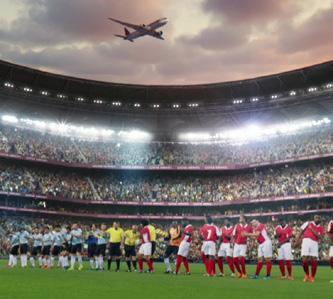
3 minute read
Dancing In The Street by Qatar Airways
Dancing In The Street by Qatar Airways

Advertisement
Not only is Qatar the host of the 2022 tournament, Qatar Airways is FIFA’s airline partner, giving it the right to use World Cup branding in its marketing campaigns.
As a result, Qatar Airways has come up with something big to mark both the tournament and its sponsorship.
In particular, the airline enlisted US singer and songwriter Nicole Scherzinger, who is also a judge on the (US / UK) reality TV show X-Factor to re-record the classic song ‘Dancing in the Street.’
Dancing in the Street, was first released as a single by Martha and the Vandellas in 1964. Nicole Scherzinger’s interpretation of the classic is the latest in a whole series of covers, with David Bowie & Mick Jagger, Van Halen and Latina pop singer “Myra” all having recorded their own versions of the song.

According to Qatar Airways, the Nicole Scherzinger re-release and video celebrate the “universal language of football.”
“We want fans to feel the fun-filled vibe that we have created with our new commercial”, said Qatar Airways Senior Vice President Marketing and Corporate Communications, Ms. Salam Al Shawa.
“Our goal is to inspire people to dance, dream and be happy as they come together from around the world for this celebration of football.”
The video itself starts with Qatar Airways staff dancing and lip-syncing to the song, while showing passengers to their seats.
It then shows a series of scenes worldwide, including the following: A British Dad being given the eye roll by his daughter for tapping along to the song while doing the ironing, some office workers doing “keepy uppy” by their desks, a group of Spanish school boys playing in a sun-drenched town square, an African lady in front of a market fruit stall while a man with a sack on his head walks past, and a procession of flagwaving fans dancing to their seats while Scherzinger sings.

Clearly this is a big budget production and Nicole Scherzinger’s involvement has resulted in a lot of exposure for the airline. The video on Facebook has (at time of writing) been viewed 13 million+ times, with over 16,000 shares.
It’s also been covered extensively in entertainment and travel publications, with music industry title Billboard calling the ad, “ebullient.”
Most of the coverage around the ad has been positive but a few commentators have pointed out the cultural stereotyping in the video.
For example, writing on the website of Australian TV network “Nine”, Sammy Stewart called it “a goldmine of ethnic stereotypes….while we’re sure the airline meant well, this 60 second “celebration” of cultures and sport is hard not to squirm through.”

Key take-away
“Dancing in the Street” is a suitably big campaign that ties into the fact that the World Cup is, along with the Olympics, the world’s largest sporting event.
The airline has pulled out all the stops in shooting the video. For example, the cinematographer they used, Tim Maurice-Jones, was involved in movies such as Snatch, Lock Stock & Two Smoking Barrels and Kick Ass.
As a result, the video has a very strong celebratory and happy tone about it, and it also very much gets across that a love for football is something that people worldwide can share in.
However we also think it misses the mark a bit. The Australian journalist who talked about stereotypes, in particular around the African market scene in the video, does have a point.
It also has a very generic “feel good”aura about it, in the sense that this is the kind of thing Coca Cola or Disney could make.
Yes, the spot included dancing and singing staff and planes flying overhead. But if you swapped the cabin crew in the film with people driving Coca Cola trucks and put a Coke logo on the video, it would 100% still work. It doesn’t say, “only Qatar Airways can do that.”
For a different creative treatment, see the next article where we talk about Lufthansa’s World Cup video.
Though a controversy around the location (it was filmed in the Ukraine but was supposed to show Russia) meant it ultimately had to be pulled, for us it worked better as a piece of airline marketing as it told a story, which Lufthansa is an integral part of.










